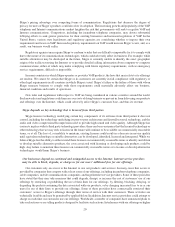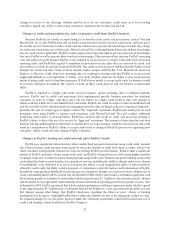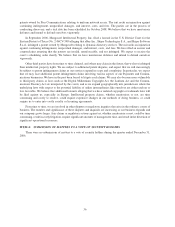eBay 2006 Annual Report Download - page 33
Download and view the complete annual report
Please find page 33 of the 2006 eBay annual report below. You can navigate through the pages in the report by either clicking on the pages listed below, or by using the keyword search tool below to find specific information within the annual report.Our industry is intensely competitive, and other companies or governmental agencies may allege that our
behavior is anti-competitive.
Marketplaces
Marketplaces businesses currently or potentially compete with a number of companies providing both
particular categories of goods and broader ranges of goods. The Internet provides new, rapidly evolving and
intensely competitive channels for the sale of all types of goods. We expect competition to intensify in the future.
The barriers to entry into these channels are relatively low, and current offline and new competitors can easily
launch online sites at a nominal cost using commercially available software or partnering with any one of a number
of successful e-commerce companies.
Our broad-based competitors include the vast majority of traditional department, warehouse, discount, and
general merchandise stores (as well as the online operations of these traditional retailers), emerging online retailers,
online classified services, and other shopping channels such as offline and online home shopping networks. These
include most prominently: Wal-Mart, Target, Sears, Macy’s, JC Penney, Costco, Office Depot, Staples, OfficeMax,
Sam’s Club, Amazon.com, Buy.com, AOL.com, Yahoo! Shopping, MSN, QVC, and Home Shopping Network.
A number of companies have launched a variety of services that provide new channels for buyers to find and
buy items from sellers of all sizes, including online aggregation and classifieds sites such as Oodle.com, Google
Base, and Microsoft Live Expo. In 2005, we acquired Shopping.com Ltd., an online shopping comparison site.
Shopping.com competes with sites such as Buy.com, Google’s Froogle, Nextag.com, Pricegrabber.com, Shopzilla,
and Yahoo! Product Search, which offer shopping search engines that allow consumers to search the Internet for
specified products. Similarly, sellers are increasingly acquiring new customers by paying for search-related
advertisements on search engine sites such as Google and Yahoo!. We use product search engines and paid search
advertising to channel users to our sites, but these services also have the potential to divert users to other online
shopping destinations.
We also compete with many local, regional, and national specialty retailers and exchanges in each of the major
categories of products offered on our site. For example, category-specific competitors to offerings in our Home &
Garden category include: Ace Hardware, Baby Style, Baby Universe, Bed, Bath & Beyond, Brookstone,
Burpee.com, Crate & Barrel, Do-It-Best Hardware, Ethan Allen, Frontgate, Harbor Freight, IKEA, HomeBase,
Home Depot, Kohl’s, Lamps Plus, Lowes, Linens ’n Things, OSH, Pier One, Pottery Barn, Restoration Hardware,
Smith & Hawken, Spiegel, Tuesday Morning, True Value Hardware, and Williams-Sonoma.
Our international Marketplaces websites compete with similar online and offline channels in each of their
vertical categories in most countries. In addition, they compete with general online e-commerce sites, such as
Quelle and Otto in Germany, Yahoo-Kimo in Taiwan, Daum and Gmarket in South Korea, and Amazon in the
United Kingdom and other countries. In some of these countries, there are online sites that have much larger
customer bases and greater brand recognition than we do, and in certain of these jurisdictions there are competitors
that may have a better understanding of local culture and commerce than we do.
The principal competitive factors for Marketplaces include the following:
• ability to attract buyers and sellers;
• volume of transactions and price and selection of goods;
• customer service; and
• brand recognition.
With respect to our online competition, additional competitive factors include:
• community cohesion, interaction and size;
• website ease-of-use and accessibility;
• system reliability;
• reliability of delivery and payment;
29
























